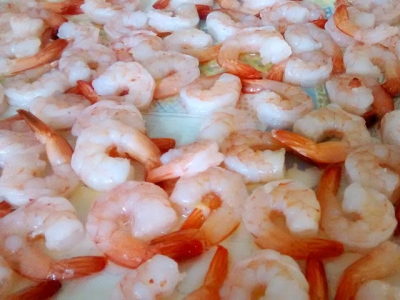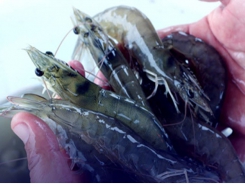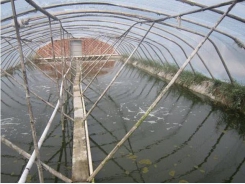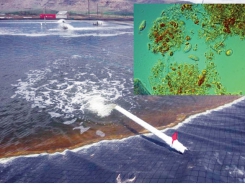New killer shrimp virus threat in China as production drops

Various diseases and viruses have hit China’s shrimp production over the past few years, but there is another “killer” one spreading.
The issues with acute hepatopancreatic necrosis disease (AHPND) -- more commonly known as early mortality syndrome, or EMS -- and other diseases are being added to by the emergence of shrimp hemocyte iridescent virus (SHIV) in China.
During the recent Aquaculture Roundtable Series, or TARS, conference in Chang Mai, Thailand, Robins McIntosh -- senior vice president with Charoen Pokphand Foods (CP Foods) -- flagged up SHIV, as he forecast shrimp production in China will drop in 2018 to 512,000 metric tons (see slide below). At the start of the year, an increase in production in China was being forecasted.
One of the emerging issues in China is SHIV.
“SHIV in China… it needs to be watched, it is a killer,” McIntosh told the audience at TARS, at the end of a presentation largely about the strong production worldwide and the need for better marketing, as farmers have learned to manage AHPND/EMS, whitespot and enterocytozoon hepatopenaei, or EHP.
It is “what is known as an emerging pathogen”, McIntosh told Undercurrent News. “We know it kills shrimp, we know it is in China, we don’t know it is a big deal. But, vigilance is required.”
There has been “very little testing” done, so there are few facts, he said. “I don’t know if it's outside of China. But, again, emerging pathogens require vigilance.”

SHIV was first detected and identified in samples of diseased Litopenaeus vannamei shrimp collected from a farm in Zhejiang Province, China, in December 2014, according to a report from a group of scientists from Qingdao’s Chinese Academy of Fishery Sciences.
The scientists’ findings “underscore the need for professionals versed in aquatic animal health and farmers in the shrimp aquaculture industries to pay closer attention to SHIV and to take more effective measures for preventing the disease outbreaks and economic losses caused by SHIV”, the report states.
Test results revealed that not only vannamei, but Fenneropenaeus chinensis, and Macrobrachium rosenbergii shrimp were also SHIV-positive, indicating “a new threat existing in the shrimp farming industry in China”, they wrote.
The study suggests SHIV is spreading and has been present for some time in the country.
According to the study, the “results of epidemiological survey indicated that this virus might not be the first outbreak in the [Zhejiang Province] farm”.
A total of 89 out of 575 vannamei individuals, five out of 33 chinensis individuals and five out of 10 rosenbergii individuals “were SHIV positive in samples collected during 2014-2016 in 20 counties of five provinces over China, raising the concern that the virus may have widely spread and aggravated to the surrounding shrimp farming areas”, they wrote.
“In conclusion, through isolation, reinfection and histopathological characterization, we have revealed that SHIV is a new virus in family Iridoviridae and a pathogen of L. vannamei.”
The symptoms of SHIV infection “include slight loss of color on the surface and cut of hepatopancreas, empty stomach and guts, soft shell in partially infected shrimp and slightly reddish body in one-third of individuals”, the report states.
Characterization of a new member of Iridoviridae, Shrimp hemocyte iridescent virus (SHIV), found in white leg shrimp (Litopenaeus vannamei)
Abstract
A newly discovered iridescent virus that causes severe disease and high mortality in farmed Litopenaeus vannamei in Zhejiang, China, has been verified and temporarily specified as shrimp hemocyte iridescent virus (SHIV). Histopathological examination revealed basophilic inclusions and pyknosis in hematopoietic tissue and hemocytes in gills, hepatopancreas, periopods and muscle.
White leg shrimp Litopenaeus vannamei is one of the most important crustacean species in worldwide aquaculture, especially for the coastal developing countries. The production of this species has accounted for 53.1% of total production of crustaceans for the world aquaculture and 98.6% of L. vannamei was produced in developing countries in 20149. However, emerging diseases recently occurred in farmed L. vannamei have significantly and negatively impacted shrimp farming industry along with the spread of the species10.
Observation and detection of diseased shrimp
The samples of L. vannamei (No. 20141215) collected from the pond with massive die-offs exhibited obvious clinical signs, including empty stomach and guts, pale hepatopancreas, and soft shell. The shrimp samples were tested and demonstrated to be free of white spot syndrome virus (WSSV), yellow head virus (YHV), Taura syndrome virus (TSV), infectious hypodemal and hematopoietic necrosis virus (IHHNV) and Vibrio parahaemolyticus, which cause acute hepatopancreas necrosis disease (VPAHPND) by PCR or RT-PCR methods recommended by the World Organization for Animal Health11 and Flegel & Lo12.
Confirmation of the causative pathogen by experimental challenge
To further identify whether the potential iridescent virus was the aetiological agent, we conducted experimental challenges to two groups of health shrimp L. vannamei by either intramuscular (im) injection or anal reverse gavage (rg) with 0.22 µm filtered suspension of the pellet under 30% (w/w) sucrose spun from homogenate of the cephalothorax of frozen shrimp of sample 20141215. Oral administration (per os) with tissue of frozen shrimp of sample 20141215 was simultaneously conducted to another group of health shrimp L. vannamei.
Results of challenge tests showed that cumulative mortality of shrimp in inter-muscular injection group (im), anal reverse garvage group (rg), and the oral administration group (per os)groups all reached 100% within two weeks of post-infection. The median lethal time (LT50) of the im group was 3.34 ± 0.32 d, which showed the fastest mortality. The LT50 of rg was 5.69 ± 0.48 d. The LT50 of per os was 8.11 ± 0.81 d. In contrast, there were less than 0–10% mortality of shrimp in the control group by im and rg with PPB-His buffer (376.07 mM NaCl, 6.32 mM K2SO4, 6.4 mM MgSO4, 14.41 mM CaCl2, and 26.10 mM histidine hydrochloride, pH 6.5)23 (Fig. 3).

Figure 3
Cumulative mortalities of L. vannamei in experimental infections. Two groups of shrimp were challenged with filtrate of tissue extracts by either intermuscular injection (im) injection or anal reverse garvage (rg). Another group of shrimp was challenged via per os infection (per os). The the control groups were treated in the same way with PPB-His buffer in group im (c) and group rg (c), respectively, or fed with shrimp feed in group per os(c). Cumulative mortalities are shown as means of data from 3 replicates for each experimental group (each replicate included 30 individuals).
L. vannamei challenged with the viral preparation from the sample 20141215 exhibited the symptoms similar to those in the original individual sample, including empty stomach and guts in all diseased shrimp, slight loss of color on the surface and section of hepatopancreas, and soft shell in partially infected shrimp. One third of individuals had slightly reddish body (Fig. 4a,b). The moribund shrimp lost their swimming ability and sank to the bottom of water. The symptom and mortality were observed in the infected L. vannamei from post larvae to sub-adult shrimp in the laboratory.

Figure 4
Clinical symptoms of L. vannamei challenged with the potential iridescent virus compared with those of the control group. (a) External appearance of the shrimp. (b) Section of hepatopancreas.
Histopathological examination showed the presence of karyopyknosis and basophilic inclusions in hematopoietic tissue, hemocytes in gills and sinus of hepatopancreas. All of these observed symptoms were identical to those in the sample 20141215 collected from the diseased pond, which was in accord with the Rivers’ postulate.
In addition, the results of RT-PCR and PCR analyses also indicated that all the shrimps from the infected group were strongly positive for the potentially new iridescent virus but no WSSV, IHHNV, VPAHPND, YHV and TSV were detected whereas all the above-mentioned pathogens were not detected in shrimps from the control group.
Discussion
In recent years, epizooties of infectious diseases in farmed L. vannamei have caused massive economic losses in China. Diseased shrimps in many cases exhibited hepatopancreatic atrophy with fading color and a high mortality. It is commonly believed that acute hepatopancreatic necrosis of juveniles shrimp is related to AHPND caused by the virulent Vibrio parahaemolyticus 14–17.
In 2014, pond-farmed L. vannamei (2–3 cm) with massive die-offs exhibited hepatopancreatic atrophy with fading color, empty stomach and guts, and soft shell in Zhejiang Province, China. Nested PCR or RT-PCR results showed that it was negative for WSSV, IHHNV, VPAHPND, YHV and TSV11. Histological sections revealed that the disease might be caused by a suspected viral infection with obvious pathogenic symptoms, which did not match the histopathologic characteristics of infection with any known viruses and AHPND. High-throughput sequencing and BLAST revealed that a potential iridescent virus was present in the sample 20141215.
The highest percentages of identities in amino acid sequence of the MCP and ATPase genes of the iridescent virus with those of the known members of family Iridoviridae were only 56% and 52%, respectively. The phylogenetic analysis of the two proteins support that SHIV does not belong to any known genus of family Iridoviridae.
The challenge tests via invasive mode of intramuscular injection or noninvasive mode mimic natural methods, including reverse gavage or per os infection that could successfully pass filterable infectious agent from the disease shrimp to healthy L. vannamei, caused similar gross clinical symptoms and pathological changes. It has been proved that this virus is the causative agent of the disease. ISH with the digoxin labeled probe showed consistent signals with the inclusions observed in the H&E-stained histopathology in the hematopoietic tissue, gills, hepatopancreas and periopods.
These results fulfilled Rivers’ postulates for the demonstration of a viral aetiology18. After having compared the morphological, physiological and phylogenetic characteristics of strain 20141215 with those of other iridescent viruses, we temporarily specified the aetiological agent as shrimp hemocyte iridescent virus (SHIV), which could cause shrimp hemocyte iridescent virus disease (SHIVD). A new genus of Iridoviridae was suggested as Xiairidovirus, which means shrimp iridescent virus.
To date, only 5 iridoscent viruses found in crustacean, including SIV infecting sergestid shrimp Acetes erythraeus were reported5: CQIV infecting freshwater lobster Cherax quadricarinatus 8, an irido-like virus infecting marine crab Macropipus depurator 4, a putative iridovirus infecting penaeid shrimp Protrachypene precipua 6, and IIV-31 infecting pill bug Armadillidium vulgare 7. Only completed genome sequence of IIV-31, gene mcp sequence of SIV, and gene mcp partial sequence of CQIV were published. It is noticed that CQIV can cause high mortality to L. vannamei in the experimental challenge.
However, the test of challenge used an intramuscular injection method rather than a non-invasive experimental procedure. According to the OIE criteria for listing species as susceptible to infection with a specific pathogen19, L. vannmei cannot be confirmed as a susceptible host of CQIV based on currently published data. Therefore, we suppose that SHIV is the only reported iridescent virus with the MCP and ATPase sequences available and a susceptible host penaeid shrimp L. vannamei.
The clinical symptoms of SHIV infection include slight loss of color on the surface and cut of hepatopancreas, empty stomach and guts, soft shell in partially infected shrimp and slightly reddish body in one third of individuals. These symptoms are not similar to those caused by the infection with putative iridovirus in penaeid shrimp Protrachypene precipua with a whitish coloration6 and the infection with SIV in sergestid shrimp Acetes erythraeus with pale and whitish body or strong blue-green iridescence in the severely affected shrimp5. Xu et al.8 did not mention the gross sign except the mortality of freshwater lobster Cherax quadricarinatus naturally infected with CQIV. They briefly described cessation of feeding and flaccidity at 5 d post-infection (dpi) followed by a high mortality of freshwater lobster Cherax quadricarinatus and L. vannamei via intramuscular injection with purified CQIV.
SHIV was firstly detected and identified in samples of the diseased shrimp collected from a farm in Zhejiang Province, China, in December 2014. However, results of epidemiological survey indicated that this virus might not be the first outbreak in the farm. Of a total of 89 out of 575 L. vannamei individuals, 5 out of 33 F. chinensis individuals and 5 out of 10 Mb. rosenbergii individuals were SHIV positive in samples collected during 2014–2016 in 20 counties of 5 provinces over China, raising the concern that the virus may have widely spread and aggravated to the surrounding shrimp farming areas.
In conclusion, through isolation, reinfection and histopathological characterization, we have revealed that SHIV is a new virus in family Iridoviridae and a pathogen of L. vannamei. Additionally, we developed an ISH assay and a nested PCR method for the specific detection of SHIV. These findings underscore the need for professionals versed in aquatic animal health and farmers in the shrimp aquaculture industries to pay closer attention to SHIV and to take more effective measures for preventing the disease outbreaks and economic losses caused by SHIV.
Có thể bạn quan tâm
Phần mềm

Phối trộn thức ăn chăn nuôi

Pha dung dịch thủy canh

Định mức cho tôm ăn

Phối trộn phân bón NPK

Xác định tỷ lệ tôm sống

Chuyển đổi đơn vị phân bón

Xác định công suất sục khí

Chuyển đổi đơn vị tôm

Tính diện tích nhà kính

Tính thể tích ao hồ




 Lobster shell disease moving towards Maine
Lobster shell disease moving towards Maine  Do current shrimp practices favor EMS?
Do current shrimp practices favor EMS?